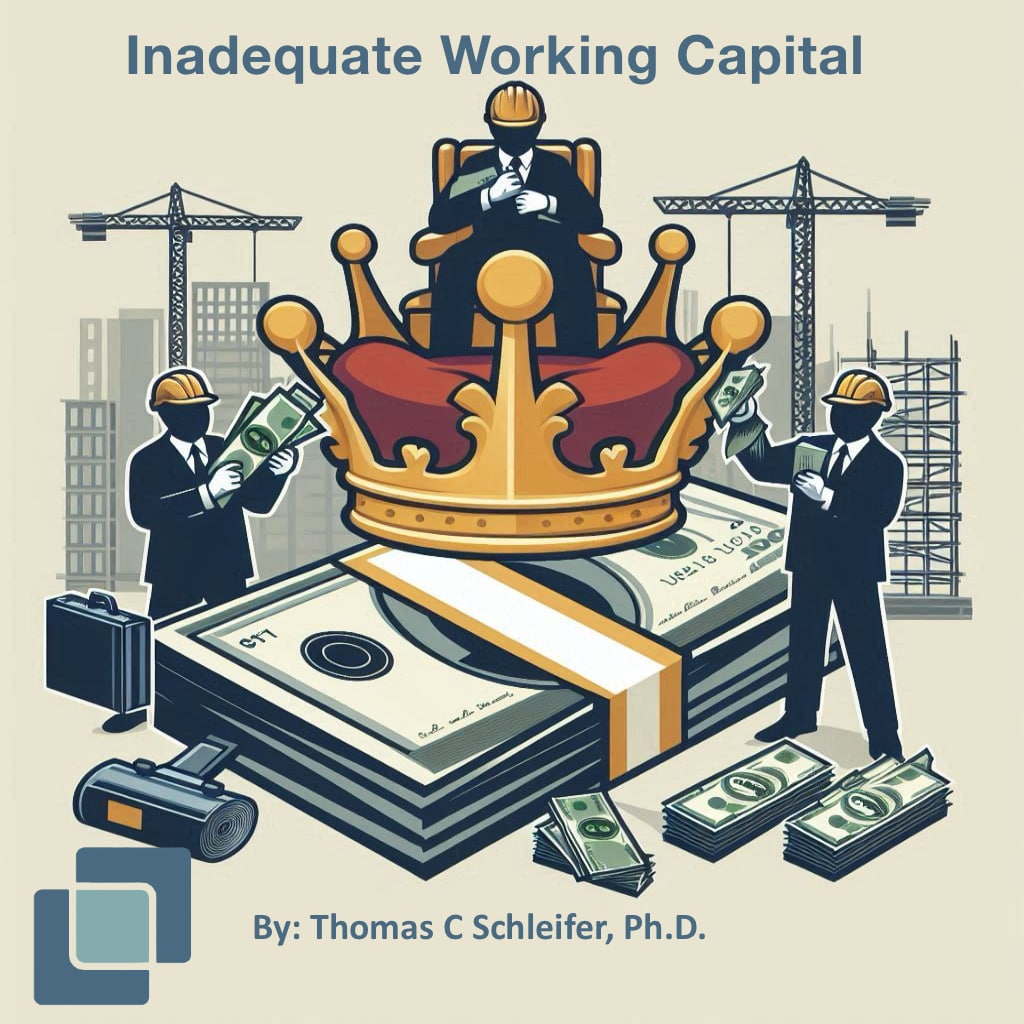
The definition of “working capital” in a contracting firm differs slightly from the classic accounting definition for other industrial concerns. Since contracting is not a “cash and carry” business where the product is paid for in advance or when purchased, we are in the process of identifying how much capital it takes to cover the costs of providing services in advance of the first progress payment. We are also trying to identify the cash flow needs to cover “late progress payments”, “inaccurate progress billing”, “payments in contention”, and the amount “retained” by the buyer to guarantee final performance. These are the “costs” that must be financed by contractors until they can collect full payment. This would be a simple task if contractors were working on only one contract at a time. However, contractors are working on multiple projects simultaneously so the timing of the numerous and varying upfront costs of late payments, under billing, and contentious payments becomes extremely complicated. Estimating the amount of working capital required at any given moment in time becomes even more challenging.
Step One: Working Capital Available
In construction, the formula for discerning working capital on hand becomes:
Cash on hand + accounts receivable due within 30 days + accounts payable due beyond 30 days + contended payments resolved and due + retainage payable within 30 days + unused portion of working capital lines of credit = working capital available for ongoing operations.
Step Two: Variables
Only cash and unused line of credit are hard data points. The others are variables depending on the performance of each client. These amounts must be assigned a discounting risk factor based on performance history. (A receivable may be due within 30 days but what if the client doesn’t pay on time.) It is the variance of one or more of these working capital elements that trips up some contractors and puts them into financial distress.
Step Three: Assigning Risk
The likelihood that a client will perform as agreed and pay on time must be estimated based on the contractor’s history with that client. Each client represents a different risk factor, and new untested clients get assigned a risk factor common to all clients. Only an experienced CFO can develop an algorithm that will accurately assign risk factors and continuously adjust the four expected amounts monthly.
Step Four: Cash Flow Plan
Accurately estimating the availability of working capital one month in advance is a cash flow plan. However, contractors often have operating plans a year or more in advance and should forecast cash flow to match their operating plan.
Step Five: Go/No Go
The cash flow plan should be reliable enough to be used as a “go/no go” hurdle when considering new work. Because growth always requires an increased need for working capital, growth represents the increased risk of running out of money in a chronically undercapitalized industry. Whether a contractor will have enough working capital to finance their planned growth is a critical factor that can be managed professionally. A reliable cash flow plan should be one of the deciding factors in whether to take on future projects or to pass on them because you need to know in advance if your cash flow will be adequate to handle the increased workload. In other words, the cash flow calculations are a planning tool, not a financial report.
From The CFO’s Viewpoint
As a planning tool, the CFO might apply traditional financial ratios to enable them to test the company’s projected working capital adequacy against the company’s most abundant cash flow periods. Your CFO may use cash flow plan data points to answer some of the following queries:
Days sales outstanding = (Receivables/Revenue) x 365. Cash is king and a business capable of converting its receivables into cash quickly is a great sign of health and efficiency. A low ‘days sales outstanding’ number means that it takes a company fewer days to collect its accounts receivable.
Cash Conversion Cycle:
1. You start with cash.
It becomes accounts payable as you buy products from a supplier.
You receive the products
The products are then sold and become accounts receivable.
Accounts receivable is collected, and you have cash again to restart the cycle from step 1.
The faster the cycle of cash, the quicker it can be reinvested to generate earnings. Regardless of what contractors believe, cash is and always will be king. No business can start or grow without cash. That’s why growth and start-up companies are constantly looking to raise cash.
Next Week we’ll take a deeper dive into the critical working capital management role of the professional CFO.
For more information working capital, read more at: CAPITAL
For a broader view on risk management, read more here: RISK
To receive the free weekly Construction Messages, ask questions, or make comments contact me at research@simplarfoundation.org.
Please circulate this widely. It will benefit your constituents. This research is continuous and includes new information weekly as it becomes available. Thank you.


